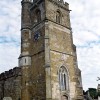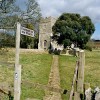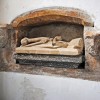In Speed’s plan of Dorchester published in 1610, the gallows prominently illustrated as two uprights with a connecting crossbeam, was marked at the junction of what today is Icen Way and South Walks. In an earlier time, Icen Way was known as Gaol Lane and started at the Gaol then on the corner of High East Street; the final section leading to the gallows was known as Gallows Hill and for many men, women and children the journey along Gaol Lane was their last.
This final journey along the narrow lane from jail to gallows was for some, heretics and traitors, even more of an ordeal. Dragged by their heels by horses frightened by the crowd to be strung up and disembowelled while still alive, their quartered remains boiled before being despatched to outlying villages as a warning to others.
Dorchester the county town was host to the Assizes, sentences handed down were quickly executed, and in those days the theft of a few shillings would merit a death sentence. Following the Assizes there was a barbaric spectacle thought by government to improve the morals of the people. Actually, the opposite was true, the crowds often numbering thousands drank too much and degenerated into a drunken rabble shouting, cursing and jeering at those unfortunate beings who, to use the term of the times, were to be “turned-off.”
Nearly a century later the Dorchester gallows was moved to the Roman amphitheatre then as now known as Maumbury Rings. The young Mary Channing was brought here in 1703 and burned alive in front of a crowd said to number thousands. (See ‘Mary Channing – a path to the gallows’ in our Archived Articles section-Ed.) Females found guilty of crimes that are more serious were frequently burned alive presumably this was considered more humane than hanging, drawing and quartering, the fate endured by men.
Death by hanging was in practice death by slow strangulation; not until the early years of the 19th century was the longer drop allowed.
The Lent Assizes at Dorchester in 1801 tried 48 cases mostly for theft. Several people found guilty of minor offences were ordered to be transported. (See ‘Transported to such place beyond the seas’ in Archived Articles – Ed.) Ten were sentenced to death including one woman, Lydia Hiskins; she had stolen a bank note.
By the mid 19th century the long drop had been in use for nearly fifty years and the gallows had been arranged at the entrance to the prison in North Square and later moved inside the prison to a spot with views overlooking the meadows by the river.
One of the last public executions at the prison entrance was that of Martha Brown, which was witnessed by a young Thomas Hardy and is said to have haunted him all his life. (See Elizabeth Martha Clarke – “a most kind and inoffensive woman.” Published 24th December 2009 in Real Lives category.)
“Hang Fairs” held below the jail would attract people to Dorchester from all over the county. By daybreak all the best vantage points were taken and the spectators occupied their time drinking, fiddling and dancing. Two centuries on and the public was still attracted to these dreadful spectacles, viewed by many as a free entertainment.
The Royal Mail coach from London pulled in to the King’s Arms at about 9.30 a.m. after a 13-hour journey from London and its arrival determined the time of execution, usually stayed in case there was a last minute reprieve from London.
The last public execution at Dorchester was in 1863. Two men, Preedy and Fooks, were to die on the same day. The Vicar of Fordington, The Rev. Henry Moule, was concerned about Preedy and frequently visited the man in jail. Following the executions The Rev, Moule published a book entitled ‘Hope against Hope,’ an account of Preedy’s life and his repentance. (See ‘The Prisoner a Padre Befriended’ published 9th February 2010 in the Real Lives category.)
This double execution drew thousands from far and wide. It was reported that two brothers erected a grandstand on the meadows and charged for seats. Their enterprise was so well supported that the stand collapsed under the weight of the spectators who all subsided into the mud below.
For year’s the saddler’s shop now long closed but then in High East Street supplied the new rope needed for the gallows. This was always the best quality hemp and probably supplied from Bridport.
In the Dorchester Gallery at the CountyMuseum there are on display two lead weights each about the size of a brick, engraved with the word “Mercy.” Silvester Wilkins was a very light man and even with the benefit of the long drop he faced a lingering death, the weights were a humane gesture from the Governor of the jail. Wilkins was executed in 1833.
Six Roman Catholics were executed on a charge of high treason during the reign of Queen Elizabeth I and then there were the 13 prisoners condemned by Judge Jeffreys, who suffered on the old Gallows Hill. The thirteen were hung in succession one after the other, their bodies treated in the manner reserved for traitors. The quarters of 12 men were distributed in Dorchester and the body of one man handed to his friends by order of the Judge.
There is reference in the Weymouth and Melcombe Regis records to a bill of costs in connection with a gallows erected at Greenhill. It reads: “Disbursements for the gallows, burning and boiling the rebels executed per order of this town – £15 14s. 3d.” It is reported that the horrible preparations for the final disposal of the bodies went on in the sight of the victims. These horrors would have been repeated at Dorchester, Lyme Regis and other towns in the county.
The last execution at Dorchester was of David Jennings who had murdered a night watchman. Jennings was 21 years old when he was executed in 1941.



